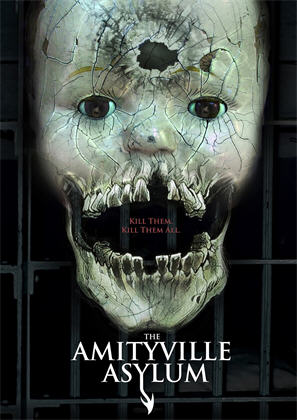
“I wouldn’t be surprised if it was haunted. I was telling my dad about your new job. You know that the asylum was only built there a couple of years ago? He said that it was built on the site of 112 Ocean Avenue…”
Director: Andrew Jones
Starring: Sophia Del Pizzo, Lee Bane, Jared Morgan, Eileen Daly, Ina Marie Smith, Paul Kelleher, Kenton Hall, Sarah Louise Madison, Alan Humphreys, Matthew Batte, Judith Haley, John Andrews
Screenplay: Andrew Jones
Synopsis: In 1974, in Amityville, a young man is handed a shotgun by a cloaked figure, who tells him: “Kill them; kill them all…” Nearly forty years later, despite a terrible interview with facility head Dr Elliot Mixter (Jared Morgan), Lisa Templeton (Sophia Del Pizzo) is offered a job as a cleaner at the High Hopes Hospital, a mental-health facility. Presenting herself for induction, Lisa meets Delaney (Lee Bane), her supervisor and co-worker, who instructs her in her duties and escorts her around the hospital. He explains that the main cleaning is done overnight, so as not to disturb the patients; and that while they will not generally interact with the patients, they will be required to clean up if any of them has an accident. Delaney also explains that while the patients in the main wards are harmless, Lisa will be required to clean in Ward X – “Blood Row” to the staff – where the criminally insane are confined. Delaney points out to Lisa three of the most infamous patients: Jerry Kimble (Alan Humphreys), a sexual psychopath; Dennis Palmer (Matthew Batte), “the Long Island Cannibal”; and Sadie Krenwinkel (Eileen Daly), a member of a cult that practised human sacrifice. There is also “Patient X” (John Andrews), an amnesiac found wandering in the grounds, who subsequently killed a doctor. On her first night on the job, Lisa is startled when she sees a girl in her early teens sitting in one of the corridors; she goes obediently when Lisa urges her to return to bed. However, when Lisa tells Delaney about this, he insists that the hospital’s youngest patient is twenty. Lisa is adamant, and Delaney informs Hardcastle (Paul Kelleher), the chief orderly, insisting upon a search. The men find nothing, and a hostile Hardcastle vents his frustration at Lisa. Delaney asks Lisa to empty the bins in Dr Mixter’s office for him, while he checks the boiler. While there, her eye is caught by the file of Patient X. She cannot help glancing at it curiously—but almost immediately, she is caught by Pemberton (Kenton Hall), who tries to demand favours from her in exchange for his silence. Delaney intervenes, escorting Lisa away. Despite all this, Lisa persists with the job, as she needs the money so badly. One night, she is startled by an encounter with the catatonic Mrs Hardesty, who she finds standing in a corridor. As she moves away to get an orderly, she hears a voice tell that she is going to die…but when she swings around, Mrs Hardesty is still and silent. However, when Lisa returns with Hardcastle and Pemberton, the corridor is empty—and when she tells them who she saw, she learns that Mrs Hardesty died that morning… Bewildered, Lisa walks slowly away—and catches another glimpse of the mysterious girl, who leads her on a chase down the stairs to the basement—and into Ward X, where the patients somehow sense her presence… At home and asleep, Lisa dreams of her mother, who she nursed through the last six months of her terminal illness; but other things intrude into her dream, including a pentagram surrounded by candles, on which blood is dripping… The next night, as Lisa mops the hallway floor in Ward X, Sadie Krenwinkel calls out to her, telling her that she has been talking to her mother—and then begins to describe private family moments that she couldn’t possibly know about…
Comments: “Asylum”, yes… For me, the most entertaining thing about The Amityville Asylum – and no, it wasn’t watching the film – was the discovery that somewhere in the wilds of Wales lurks an individual whose life’s ambition is apparently to beat The Asylum at their own game.
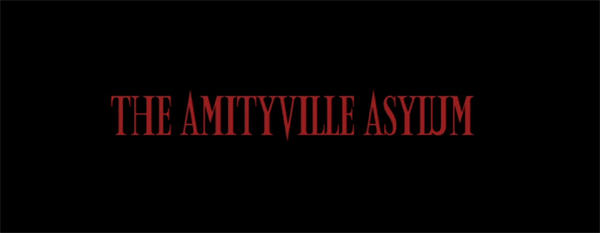
The IMDb page for Andrew Jones – who with respect to The Amityville Asylum should be more correctly referred to as producer-director-screenwriter Andrew Jones – offers an eyebrow-raising list of past, current and future projects that are, on the basis of their titles, at least, riffs upon every horror subgenre of the past ten years to be even remotely popular. Thus we find amongst the titles a creepy doll film (Robert, which rates a sequel), a The Exorcism Of— film, an A Haunting At— film, and a nod at the recent wave of Nazi zombie films, Werewolves Of The Third Reich; not to mention a couple of more obscurely-titled mash-togethers like Cabin 28 and The Last House On Cemetery Lane; as well as the almost charmingly inevitable Poltergeist Activity.
Add to this a couple of faux-sequels, Night Of The Living Dead: Resurrection and Silent Night, Bloody Night: The Homecoming, and the existence of The Amityville Asylum begins to make a kind of sense.
(While we’re on the subject of faux-sequels— For reasons I cannot even begin to understand, this film was released in Germany as The Nesting 2: Amityville Asylum.)
The other accidental entertainment associated with The Amityville Asylum emerged when I started reading around this production—and came across a squadron of people who wanted to tell me that, There really *is* an Amityville Asylum, they just changed its name.
As with so much in this area, there’s a nugget of truth in the centre of that statement; not to mention a real-life story more interesting, and disturbing, than what ended up on film. There is indeed a mental-health hospital in Amityville—though as far as I can determine it was never officially called “the Amityville Asylum”: rather, the facility acquired that shorter nickname in the face of its actual title, The Long Island Home Hotel For Nervous Invalids; and you can find references to the place under that name in newspapers dating up to 1926. The hospital did have its name changed in the 1950s, but to South Oaks; and is still known as that today.
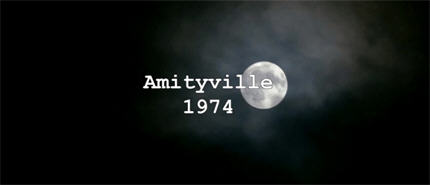
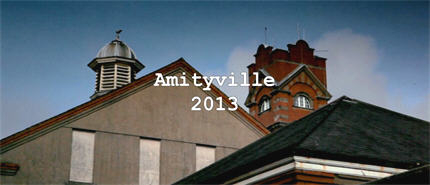
It’s the gift that just keeps on giving.
The hospital’s own documentation paints a rousing picture of high-standard services and progressive thought; though behind this, as is not uncommonly the case with mental-health institutions, there are darker stories lurking, including of electroshock therapy without consent, and the fact that Harold Abramson, who headed up the CIA’s notorious LSD experimentation program, was once on staff as the Director of Research. Nevertheless, for many years after its founding the “Amityville Asylum” was a go-to place for dropping off New York’s more awkward cases, and various celebrities darkened its doors over the years. Some of them never came out again—including Maurice Barrymore, patriarch of the acting clan, who died there in 1905.
All that said— The repeated assertion that Ronald DeFeo Jr was once under treatment there seems to be a perverse kind of wishful thinking…
Though various allusions to the history of the real Amityville Asylum occur in this film (including an episode of unauthorised shock treatment), this fiction is ultimately a lot less interesting than the fact. Much of this is consequence of the film’s low-low budget, exacerbated by a lethargic screenplay and a series of peculiar artistic choices.
However, there are other factors creating a barrier between The Amityville Asylum and the viewer that are a bit more esoteric. While the film is set on Long Island, it was partly shot in Wales, and its cast is predominantly British—a situation which had the unhappy side-effect of forcing the actors to concentrate their efforts, not upon their performances, but on the struggle to disguise their accents. Most of them take the obvious option and settle for trying to sound American, but a shout-out to Lee Bane for his unexpected choice to try and sound Eastern European (albeit that his character is called “Delaney”).
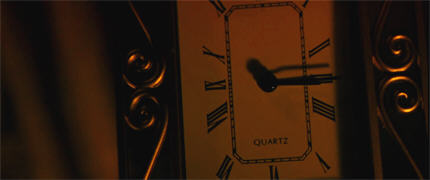
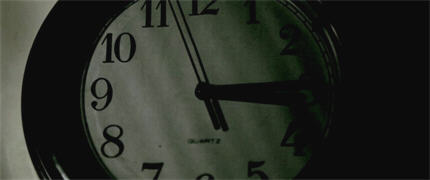
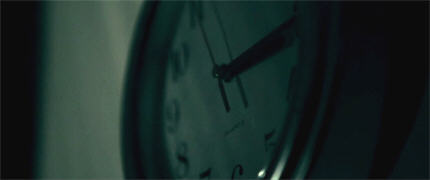
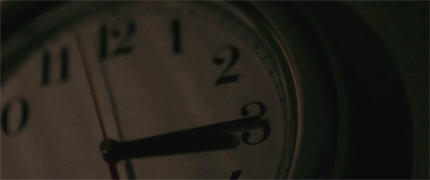
Not to labour the point, or anything…
(It occurred to me while I was listening to all this desperate straining after Americanism that John G. Jones’ The Amityville Horror Part II has the supernatural forces pursuing the fleeing Lutzes all the way to England—and that a story along those lines might have been a more sensible choice for a British production. It is, however, very noticeable that The Amityville Asylum goes out of its way to avoid referring to the Lutzes by name, so I’m guessing that for legal reasons this wasn’t an option.)
But stubborn vowel-sounds are hardly the only obstacle that The Amityville Asylum fails to overcome. The film creates another difficulty for itself in the way it uses the franchise’s back-story. There are some series entries that try to play along with the film mythology, and some that ignore it altogether, but The Amityville Asylum takes a falling-between-two-stools approach, going along the true story just so far as to make it really annoying when it subsequently diverts from it.
Furthermore, the film adopts this half-and-half approach from its very first moments, when it opens with yet another re-enactment of the DeFeo murders, and takes some care (much more than was needful, in context) to show the murders committed as they really were in terms of the shots and who was awake (except for Dawn, who is shown sitting up and facing her killer, when she was found dead in a sleeping position; possibly this is a nod at the version of events that has her as a second shooter)—but has the murders committed with a shotgun instead of a rifle.
Perhaps the production had a prop shotgun available but not a prop rifle? I suppose that’s the simplest explanation. Still, this intrusively wrong detail is the kind of thing that does tend to raise the hackles of those who have stuck with the franchise this far.
Both of us.
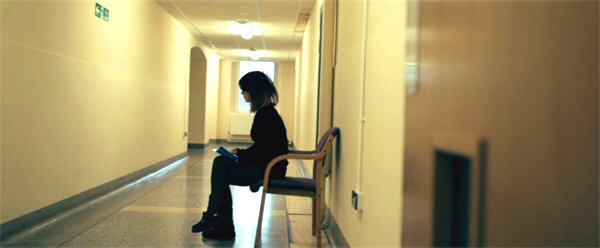
“I can’t believe I’m the only one who showed up for the audition…”
The murders, I should mention, are preceded by a glimpse of a cloaked figure, which emerges from the shadows to hand the aforementioned shotgun to Ronald DeFeo Jr with a whispered command to: “Kill them. Kill them all…”
From 1974 we leap forward to 2013, and find a nervous Lisa Templeton waiting for a job interview—and immediately the film’s restricted budget, and its consequently restricted cast, makes themselves painfully felt as Lisa, applying for a cleaner’s job, is interviewed by the head of the hospital.
Uh, yeah. That’s not how it works.
Mind you— Dr Elliot Mixter does rather project the air of someone whose level of authority extends no further than supervision of the cleaning staff; as opposed to the powerful figure he is supposed to be, a man who pushed through the building of his hospital against community opposition, and who now proceeds to lecture Lisa about its mission and its aspirations to be one of the country’s leading mental-health facilities.
(Bonus points to Andrew Jones here: the hospital is called “High Hopes”, which was the bitterly ironic name of the Amityville house, and became the title of Hans Holzer’s Gerard Sullivan and Harvey Aronson’s book about the murders.)
Lisa herself (in one of this film’s few entirely realistic touches) stumbles and bumbles through her interview, revealing painful details about nursing her mother during her terminal illness in order to make herself seem qualified for hospital work and agreeing, with desperate eagerness, with everything Mixter says. She concludes her less-than-impressive performance by sneezing on him, messily.

“I was offered the sort of luxurious office usually deemed appropriate for the head of a prestigious healthcare organisation, but I declined it because, you know, reasons.”
So when she later gets a phone-call offering her the job, her not-unnatural reaction is, “Is this a joke?”
Lisa presents herself for induction the following morning—and what is, sadly, the film’s most tone-setting scene follows, as her supervisor, Delaney, shows her the cleaning-products available to her, explains their use, and warns her of their dangers.
As this scene goes on, and on – and on – it is impossible not to conclude that what Delaney is saying, his warnings about the vacuum cleaner being much more powerful than you’re used to and the specialist stain-remover being likewise quite powerful and the chewing-gum remover producing super-heated steam and the concrete cleaner being the most dangerous chemical we have, is going to come into play later; and, naturally enough, delightful images of Lisa warding off a rampaging killer with chemicals and steam begin to dance in our heads. But, alas! – it turns out that Andrew Jones has never heard of Chekov’s gun. Try keeping your indignation under control when it later dawns upon you that this endless scene about cleaning products has nothing to do with anything.
What Delaney has to say next is a bit more on-point: he tells Lisa that one of her main areas of responsibility will be Ward B, where most of the patients are harmless—breakdown sufferers and the catatonic; although an overly-lengthy introduction to the catatonic Mrs Hardesty (who gets left sitting around in the corridor for some reason) does follow. Delaney then takes Lisa downstairs to the dreaded “Ward X”, wherein are lodged the criminally insane…
…and here The Amityville Asylum’s issues kick in in earnest.
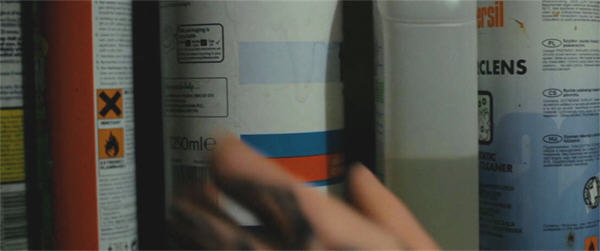
Chekov’s cleaning products.
Some of you out there will know how fond I am of mocking Haddonfield Memorial for its empty corridors and astonishing understaffing; but I’m here to tell you now that it has nothing on High Hopes Hospital, Amityville. At least Haddonfield Memorial has some medical staff, even if most of them are drunk and/or incompetent. High Hopes, conversely, is a healthcare desert island: we see no sign of any general medical staff on the premises, and no security personnel either—even though the hospital is housing some of the country’s most dangerous psychopaths.
(Or rather, the film thinks that “security guards” and “orderlies” are basically the same thing; but even allowing for that, there’s a ridiculous dearth of the latter.)
The screenplay tries to dance around this point by having most of the action take place around three o’clock in the morning (3.15 am, to be precise), and by offering references to “the other wings”; but the lack of staff is so laughable and yet so necessary to the plot, that the weight of the absurdity becomes more than the film can comfortably bear.
Delaney now introduces Lisa to Ward X’s star inmates: something he is easily able to do, as a single locked corridor door is the extent of the security arrangements; while the inmates’ cells are so flimsily built that not only can they whisper sweet obscenities to one another through the walls, but every word they say is clearly audible in the corridor. Opening the viewing panel in each cell and letting Lisa gawk, Delaney tells her about Jerry Kimble, who killed and sexually assaulted a woman – in that order – before also killing her young child; Dennis Palmer, who likes to snack on and kill – in that order – paedophiles and rapists; Sadie Krenwinkel, the last surviving member of a cult committed to human sacrifice in the pursuit of immortality; and the unidentified “Patient X”, a shadowy figure who came out of his catatonia just long enough to murder a doctor…
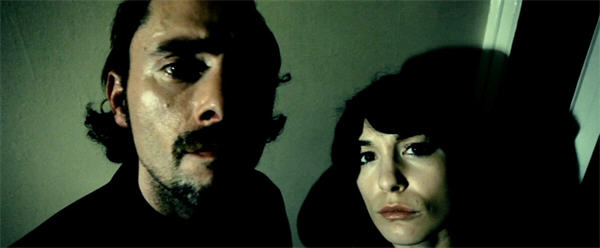
“And the patient in here— She watched every single one of the Amityville films. There’s nothing medical science can do for her…”
The “Patient X” subplot brings into focus one of the odder aspects of The Amityville Asylum which, though it uses (and abuses) the Amityville back-story, devotes quite as much energy to riffing on other films, in particular The Exorcist and, more unusually, Exorcist III. The latter is seen in the inclusion of the catatonic patients, but more obviously still in the whole “Patient X” subplot, which almost exactly reproduces the circumstances of the unidentified patient in the earlier film—who is also called “Patient X”.
Meanwhile, although Jerry Kimble is mostly irrelevant – except for his eventual fate – Dennis Palmer is a Hannibal Lector wannabe (and actor Matthew Batte consequently allowed to keep his own accent); while Sadie Krenwinkel, whose name is a mash-up of two of the Manson followers, is played by Eileen Daly. Daly has done other film and television work, of course; while if you’re watching this film in the first place, you may know her best as the face of Redemption DVD. Even so, you might not recognise her here as the moaning, cackling, eye-rolling Sadie. Daly’s over-the-top performance is one of this film’s few bright spots.
And so Lisa gets to work—and almost immediately finds trouble. She is startled when she comes across a girl in her early teens wandering the corridors, and somewhat more than startled when she learns that (i) all the patients are locked in at night, and (ii) there are no patients of that age. Lisa is so adamant that Delaney reports the matter to the chief orderly, Hardcastle, who reluctantly instigates a search. It turns up nothing, and Lisa comes out of the incident having made an enemy and acquired a reputation for “seeing things”.
Matters go from bad to worse when, while emptying the bins in Dr Mixter’s office, Lisa can’t help sneaking a peek inside the file of Patient X. She is caught by another orderly, the sleazy Pemberton, who promises to hush up her transgression if, uh, she’ll be nice to him. Delaney’s arrival defuses the confrontation.
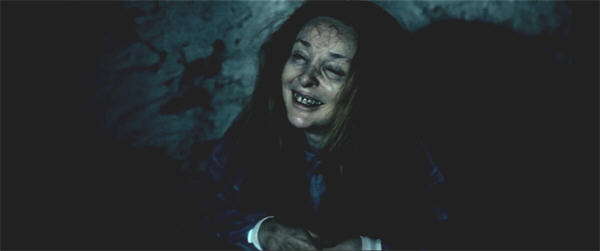
Sadie’s razor-blade smile.
And then Lisa has an odd encounter with the catatonic Mrs Hardesty—who speaks to her, uttering the Regan McNeil-esque observation that, “You’re going to die here…” Lisa steels herself to report the incident to Hardcastle and Pemberton, who guffaw incredulously; not altogether unjustifiably, since Mrs Hardesty died that morning…
It is hard to convey in words how leadenly all this plays out—or the film’s evident yet completely misguided air of believing that there is something imaginative and original about Lisa’s strange encounters. The musical sting which accompanies each of the “shocking” revelations also has to be heard to be disbelieved: a tinkly piano chord (plunk-plunk-PLUNK!) even more obvious than the incidents themselves.
Through these scenes, another of The Amityville Asylum’s serious issues emerges, this one artistic. While watching the film’s opening credits I was absurdly excited to note that this production boasts that inexplicably rare entity, a female cinematographer—but unfortunately, there’s not much positive that I can say about her work. I don’t blame Victoria Rodway for the film’s visual shortcomings, however, since they seem to be the result of some very odd directorial choices. In fact— Overall this film has a weird look which suggests that Andrew Jones actually wanted to make a found-footage film, but for some reason didn’t. The Amityville Asylum has all the familiar visual tics – a moving camera, lots of close-ups, tight framing, strange angles, shots taken through doorways and around corners, objects (and people) going in and out of focus – such that when you’re occasionally reminded that this is a conventionally staged and shot motion picture, it’s actually a bit of a shock.
Lisa is still struggling with the humiliation and confusion of the Hardesty incident when she catches another glimpse of the wandering girl as she vanishes around the corner of a staircase. Lisa pursues her, all the way down to Ward X, where she overhears some very disturbing talk…
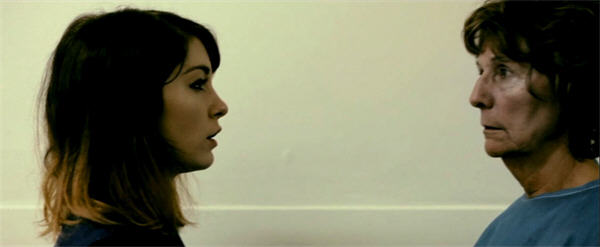
“Oh, yeah? Well— Well, you already died here! So there!”
(One of the most infamous lines of dialogue from The Silence Of The Lambs is reproduced here, although amusingly it’s been cleaned up a bit.)
Lisa tries to dodge Ward X duty for a while, but unsuccessfully. Her instincts were correct, however, since the next time she’s down there, Sadie Krenwinkel starts describing the interesting conversations she’s been having with Lisa’s dead mother, and how the late Mrs Templeton is getting along in hell…
At least she has Mrs Karras to keep her company.
The script then remembers that this is an Amityville film, not a remake of The Exorcist, and so Sadie sends Lisa on her way with what she says is a message from her mother—“GET OUT.”
From here, things get ever more lively in Ward X. First, Dennis Palmer requests medical attention after he slashes his forearm open with something sharp, which he somehow got hold of in his isolation cell. (Up the forearm, too: not a good idea unless you actually mean it.) High Hopes Hospital being what it is, Pemberton responds to this situation on his own—and, yeah, well… Palmer helps himself to Pemberton’s keys, and the next thing we know he’s in the next cell, snacking on Jerry Kimble.
Hardcastle discovers Pemberton’s body and announces, “We got a major Code 6 on Ward X!” (I wonder what a minor Code 6 is? Murder without cannibalism? Cannibalism without murder?) This brings rushing to the scene all of the resources of the High Hopes Hospital, i.e. one other orderly. Lisa’s next bit of exquisitely bad timing puts her on the spot of Hardcastle and his offsider “dealing with” Palmer, via a little unauthorised electroshock therapy.
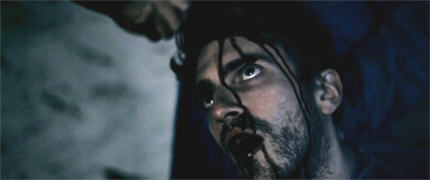
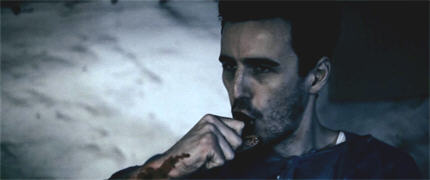
“What did you expect? The food in this hospital sucks!”
All of this, along with the hours she’s working, is not surprisingly taking its toll on Lisa, as her friend Nancy informs her when she drops in: “You look like shit.”
Ah, Nancy…
While it is true that I watch a lot of low-budget movies, I guess I can’t say that I know all that much about the day-to-day realities of getting them made; so it’s possible I’m under a variety of misapprehensions.
For example— When it came to casting people in an Amityville sequel, I would have thought that an inability to pronounce “Amityville” correctly would have been a deal-breaker; but evidently not.
Lisa confides to Nancy that she thinks the hospital is haunted, which of course prompts Nancy to reply that she wouldn’t be surprised: “It was built on the site of 112 Ocean Avenue.”
Nancy: “Are you seriously telling me that you have never heard of the Uh-mittyville horror house?”
No, really: that’s how she says it; not once, but nearly a dozen times.
And yes, Lisa has indeed managed to live on Long Island all her life without being more than vaguely aware of the DeFeo murders. She certainly didn’t recognise the address, when she went for her job interview…
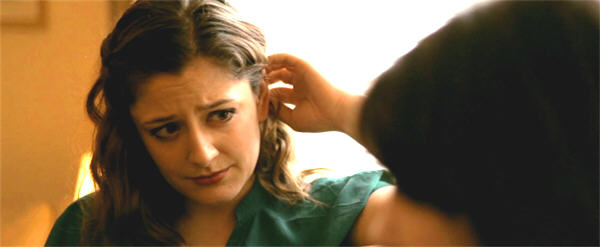
“‘Am-it-y-ville’? That doesn’t sound right…”
And that – Nancy’s little quirk aside – is what I love best about this film: the revelation that an entire mental-health facility, grounds and all, has been built not just in the middle of a residential neighbourhood, but on an ordinary suburban street.
They always forget that detail, don’t they?
The upshot of this conversation is that far from quitting, as Nancy advises, Lisa decides that she wants to “get to the bottom of things”.
It’s 2013 by now, so there’s no need for an entire day spent scrolling through the microfiche at the library (*sniff, sniff*). Instead, Lisa hops onto the internet, and with no more than a click or two discovers who it is she’s seen wandering the corridors of High Hopes…
Well. Obviously NO-ONE is paying the slightest attention to my repeated rants about the extremely poor taste inherent in using real-life murder victims – real-life child murder victims – as movie spooks. In fact, we’ve reached the point where 2005’s The Amityville Horror looks classy by comparison, since it at least invented a DeFeo child, who was doomed to wander its house’s corridors with a bullet-hole in her forehead. Come 2011 and The Amityville Haunting, however, and I could find nothing better to say about that film’s exploitation of the real John Matthew DeFeo than, “At least this time he doesn’t wander about with a bloody gunshot wound in his head.”
Famous last words. The ghost of High Hopes will shortly be revealed as Allison, the younger of the two DeFeo girls, thirteen years old at the time of her death; and while to this point her physical appearance has been unremarkable, in the future it will include, sigh, a bloody gunshot wound in her head.
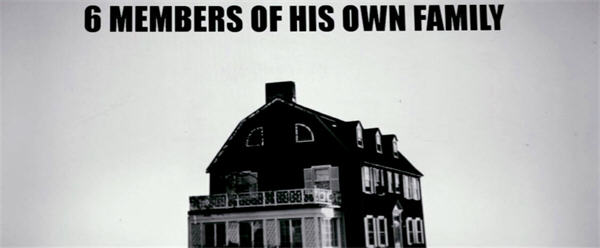
Apparently I’m not the only one the ‘ordinary suburban street’ thing occurred to.
Seriously, people. I mean— What are you going to do, keep this up until you run out of children?
Lisa carries her discoveries and fears to Delaney. Oddly enough, the scene which follows, an understandably awkward conversation between the two that expands to encompass the existence of God and the nature of evil, is actually one of the film’s best, nicely played by both Sophia Del Pizzo and Lee Bane.
Also in this conversation, Delaney makes mention of a long-past Amityville incident involving “the slaughter of Native Americans”. Lisa and Nancy go on with their researches (oh, my God! they’re looking in books!); and Nancy also reports what she has learned from a helpful librarian (ha! the library!).
This time around we get a spin on the historical story of Captain John Underhill, who after building quite a reputation as an Indian killer was hired by the Dutch on Long Island to exterminate the remaining natives, after the settlers were unable to displace them from their land. Underhill’s victims were buried in a mass grave—which may or may not have been under the area now known as Amityville. (This same story forms the basis of the Poltergeist films, of course.)
The Amityville Asylum shifts this story from the 17th century to the 18th for some reason, and then all but justifies Underhill and his fellow mass-murderers by presenting Sachem Tackapausha and his tribespeople as practitioners of black magic committed to the performance of human sacrifice in the service of “The Dark Master”, who in return was supposed to grant them immortality. Furthermore (and we have heard this one before), it has been alleged that it was Chief Sachem who “possessed” Ronald DeFeo Jr.

And guess what the date is?
And assuming we’ve been paying attention up to this point, we will now realise that the invoking of The Dark Master via the sacrifice of six human beings, as performed by Sachem and his people, is the same ritual that was being carried out by Sadie Krenwinkel and her fellow cultists, except that one of the six got away…
…although evidently Andrew Jones didn’t think we would be paying sufficient attention, because the film now has Nancy and Lisa spell it all out for us.
Two other discoveries are of more interest: (i) Dr Elliot Mixter testified at Sadie’s trial; and (ii) another round of sacrifices is scheduled.
Lisa steels herself to carry her discoveries to Mixter himself, who unsurprisingly pooh-poohs them, particularly her insistence that Sadie is getting internet access among other things, or that someone on staff is doing things for her. But Lisa persists, which at first causes Mixter to suggest ominously that she has been affected by some of the Ward X “delusions”; although finally he agrees to look into her claims, and leaves the room. Lisa has just had time to notice that the papers on Mixter’s desk are committal papers for herself when the good doctor returns, accompanied by two orderlies.
(The same number of orderlies that earlier responded to two gruesome murders: I hope she’s flattered.)
Before we know it, Lisa is in a straitjacket, having it explained to her that she was never an employee, she was always a patient…

“In light of her decision to accept a role in The Amityville Asylum, we feel we have no alternative but to…”
But despite various hints in passing about Lisa’s emotional instability in the wake of her mother’s lingering death, it is only half-heartedly that The Amityville Asylum dabbles with the idea of an unreliable narrator; and barely has Mixter left the cell after undoing the apparently quiescent patient’s bonds than Lisa defiantly spits out an unswallowed sleeping-pill.
Meanwhile, a cloaked figure that this time around we can see is Elliot Mixter offers a shotgun to Patient X: “Kill them,” he urges. “Kill them all…”
Patient X responds by killing Sadie in the first instance; pretty damn ungrateful if you ask me. Palmer and Hardcastle follow.
Hearing terrifying sounds somewhere nearby, Lisa cringes back as her own cell door opens—but it’s Delaney, come to the rescue. The two of them run for their lives, only to find their way blocked by a group of patients at one turn (this place has other patients!?), and at another by the now-bloody faced Allison DeFeo. They’re so busy gawping at her that they barely notice the shotgun-wielding figure that has loomed up behind her, at the far end of the corridor. Just in time, Delaney drags Lisa away. They run into another random patient and warn him of the danger; he responds by tearing his own face off.
As you do.
Finally the two of them come up against a locked door. Delaney fumbles with his keys, the critical one of which snaps in the lock. In desperation, he snatches up a chair, meaning to smash his way through—
—and instead takes a shotgun blast to the chest.

“And yes, you did see me getting shot in the back of the head. With a shotgun.”
Which probably constitutes the film’s best surprise, inasmuch as, given that Delaney is the one decent person amongst a positively hateful crowd, we were naturally expecting him to turn out to be one of the bad guys—right?
Unfortunately, having managed this nice sort-of twist, the film then completely undermines it by having the killer lower his gun and wait patiently until Lisa, or at least Sophia Del Pizzo, finishes having a Big Emotional Scene over the dying Delaney.
Then the chase is on again—and Lisa trips and sprains her ankle.
Really. In 2013.
I suppose I should be grateful she didn’t faint.
It’s not a bad sprain, but it slows Lisa down, so she takes refuge in a room and tries to brace the door closed as her pursuer forces it from the outside; and we get a genuinely suspenseful interlude when Lisa has to choose between continuing to hold the door or reaching for a weapon. She finally decides upon the latter, grabbing a screwdriver as the killer lurches into the room—and she doesn’t mess around while wielding it, I am happy to say…
Then, armed with the killer’s shotgun, Lisa goes gunning for Mixter. She bails him up in his office; but although he obligingly raises his hands, he is unrepentant about his role in “The Great Becoming”, the attempt to resurrect “The Dark Master”:
Mixter: “One more sacrifice is all we need…”
Lisa: “Then how about I blow your fucking head off?”
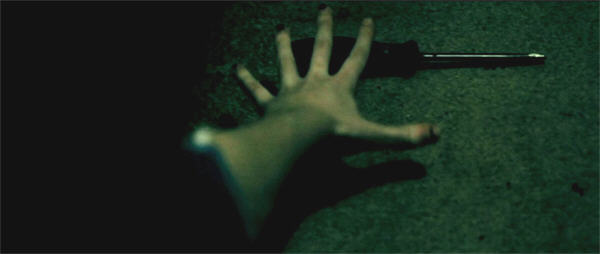
“What I wouldn’t give right now for a bottle of concrete cleaner!”
But far from trying to placate her, Mixter goes out of his way to provoke her—throwing her mother in her face, reminding Lisa of those last months, of the cancer that killed her mother as she watched—and accusing her of not really grieving, of forgetting her, oh so quickly…
But distraught and enraged as she is, Lisa controls herself. She can hear the sirens drawing near, and knows that the police will soon be there to take charge…
While a few clever touches and one or two agreeable ironies serve to prevent The Amityville Asylum from being entirely dismissible, in the end it remains a very minor franchise entry—most fundamentally, because it fails as a horror movie. It does boast a couple of decent gore effects – one in particular, towards the end – but aside from that, the film is almost scare-free. It’s even jump-scare-free, which (considering the state of this viewer’s nerves) is just a little sad.
Jared Morgan never convinces as either the head of a hospital or the head of a satanic cult, but Sophia Del Pizzo and Lee Bane are both adequate; although the former’s performance has an ad-libby quality that fits better with the film’s found-footage feel than with its objective perspective reality.
The Amityville Asylum is studded with ideas not fully worked out. Most significantly, there are hints dropped all the way through that Lisa has for some reason been “chosen”; yet nothing happens to support the idea that she, specifically, is necessary to The Great Becoming. The screenplay also commits the fatal blunder of allowing the audience far too much time to ponder its myriad implausibilities—not the least of which is the tantalising question of how the climactic sequence was planned to play out by its participants, as opposed to how it did play out.
However, the hospital itself is the film’s biggest stumbling-block. I suppose you could argue that, since the real purpose of High Hopes was to facilitate The Great Becoming, there was no need for the place to be realistic; but for that to work, you’d need everyone in on it, from the hospital accreditors to the cleaning staff. Instead we have a situation where absurd understaffing and non-existent security are treated as normal by all concerned.

112 Ocean Avenue.
[*snicker*]
And really, there’s no in-film indication that we’re not supposed to regard this hospital as the state-of-the-art facility Mixter insists it is at the outset—which makes it more than a little problematic that the scenes set at High Hopes seem to have been filmed in something like a school (and not a very new one); while the cells of the dreaded “Ward X” look like they were hastily assembled in someone’s basement.
That 112 Ocean Avenue business, though— That’s gold.
.
Footnote: From the Ironwood News-Record, 9th May, 1896:



Wow. Just wow.
A couple notes – Just how badly did Lisa need that money? Dying your hair blond destroys your mind? (which would explain all the blonde jokes)
It does sound as if a much better and scarier movie was there, waiting in the wings, hoping the main movie would sprain its ankle. I don’t think a move has been done with Dangerous Cleaning Products as the main topic. Although, just to be sure, I usually avoid cleaning my house whenever possible.
LikeLike
Lisa did need the money pretty badly: she dropped out of university (NB: the film did remember to say “school”, so that’s one correct Americanism) to nurse her mother during her terminal illness. We gather she was doing occasional house-cleaning jobs while nursing but nothing permanent.
Yes, that’s my cleaning policy, too. 🙂
LikeLike
Kill them all. The sequels first.
“a pentagram surrounded by candles, on which blood is dripping”… really, the Freudian symbolism is entirely too obvious.
If I were making films I’d be tempted to produce one called “Zombi 5: The Walking Dead 3: 2”.
A minor code 6 is murder and cannibalism by a non-named character.
That’s The Dark Master™, if you don’t mind. These days he’s living on the franchise fees.
LikeLike
If I were making films I’d be tempted to produce one called “Zombi 5: The Walking Dead 3: 2”.
…and it would be right at the top of my DVD queue!
I’m afraid Mr Subtlety and Ms Originality took the night off while this was filming.
LikeLike
Just a minor note that further shows this was filmed outside the US: in the screencap of Lisa’s institutionalization papers, her DOB is listed as “22/10/88”. Of course, in the US, that would be written “10/22/88” instead. A very minor point, to be sure, and it appears it’s far from the worst detail to get overlooked in this movie, but, y’know… sometimes, you just have to be thorough. 🙂
LikeLike
…and because that’s what we do here too, it didn’t even register with me as incorrect! I was more focused on Lisa’s birth year, since I’d been trying to work out how old she was supposed to be.
LikeLike
Reblogged this on Mike's Movie & Film Review.
LikeLike
OK, I give up. Just what is that… thing… on the poster supposed to be? Skull like (sort of), but not a skull, teeth and jaw look sort of like what you would find on a skull but there’s a nose and nostrils above them. There are non human looking glass eyes in the too small eye sockets, a burnt edged gunshot hole in the forehead and crazing lines of the sort you find on old china. It’s creepy I admit but more in an “uncanny valley” manner than gruesome or horrifying.
I’m guessing either the funding for the film was contingent upon an Amityville connection or the producers thought that putting “Amityville” in the title would increase the return on investment. Too bad, as the film might have come out better if they had just made their own movie. I did get a chuckle out of the notion of building a psychiatric hospital centered on 112 Ocean Avenue though. I figure they would have had to buy out about twenty houses minimum to get enough land. Seems like there must be more efficient ways of sacrificing a half dozen people in order to become a dark lord! I also love Lisa’s ignorance of local history – she would fit right in at Crystal Lake!
LikeLike
Ray, I think the design sensibility started and ended at “creepy”. I’m surprised there isn’t a spider involved.
“Horrible things happen in a mental hospital” (abandoned or otherwise) does seem to be one of the standard templates for first-time horror film makers, along with “annoying people run around in the woods”. Has there been a really successful horror film with that premise, that I’ve simply failed to notice? (Entirely possible.)
LikeLike
You may have failed to notice—me, too! I know there have been several recent ones with that premise and I seem to remember hearing good things about a couple, but specifics escape me.
LikeLike
That poster image is a lot creepier than anything in the film, trust me!
At least two of the earlier sequels were clearly twisted into being “Amityville” films, so that’s nothing new. Given Andrew Jones’ resume, however, I don’t think anything (like his arm) was being twisted here.
Yes, the whole build-a-hospital thing seems like overkill, if you’ll pardon the expression. You can’t even argue that they needed the connection to the land since Sadie and her crew were apparently operating elsewhere.
The only thing I can say for Lisa is that this does seem to be a world where the original murders / haunting happened but not the movies, books, etc.
LikeLike
Alternate caption to the image of the lonely girl in the corridor:
“The crowd at AmityFest was not quite as large as the organizers had hoped.”
LikeLike
Ah, but I’m sure in that case there would have been at least one more person present! 😀
LikeLike
On a related note, I would like to point out that in Edinburgh, Scotland, where I live, we’ve got a real Morningside Cemetery! Does this mean Andrew Jones will be forced to rush up here from Wales and make “Phantasm 6: Big Brass Balls”?
LikeLike
We can only hope!
We, of course, actually have a city of Townsville, for which several of my American friends have seen fit to mock me.
LikeLike
Mock you? That’s awesome!
I had no idea the Powerpuff Girls were Australian. They hide their accents well.
LikeLike
Yes, some people are very brave…at a safe distance. 🙂
Better than the actors in this film, certainly! It’s all there in the attitude, though.
LikeLike
Just think, they could have used the Dell DeForrest bit and said, “Yes, the family were so ashamed they changed their name…to DeFeo.”
And Dr. Mixter looks so much like Salvidor Dali (at least in the stills here) that it’s really distracting.
LikeLike
Holzer wrote a couple of books about the Amityville “haunting”, but High Hopes wasn’t one of them. High Hopes was the title of a true crime procedural by Gerard Sullivan, the prosecutor of the DeFeo murders. As a police officer myself, I was engrossed.
I think it’s safe to assume this movie’s “Dr. Mixter” is a nod to Ford Rainey’s character in Halloween II.
LikeLike
Hi, Joe – thanks for visiting!
You’re quite right, I mis-remembered the book titles (too many darn books!) and have corrected the review to reflect that.
I think it’s safe to assume this movie’s “Dr. Mixter” is a nod to Ford Rainey’s character in Halloween II.
Ah, yes! That’s one reference I missed—and it makes me sure Andrew Jones & Co. were fully aware of how silly their hospital was. 🙂
LikeLike
“a situation which had the unhappy side-effect of forcing the actors to concentrate their efforts, not upon their performances, but on the struggle to disguise their accents”
Heh, that reminds me. Last week my wife and I were rewatching SANTA’S SLAY for the first time since its original release, and I was highly amused at how little Emilie de Ravin was bothering to conceal her Australian accent (something I know she CAN do when she can be bothered, since she did it on ROSWELL). Half her vowels were wrong for any kind of American accent. Perhaps casting her as a small attractive woman who went by nickname “Mac” was a mistake, since it probably made her feel a little too much like she was still Down Under.
(By contrast, we also recently watched a horror movie with Adelaide Kane – some damn thing about a haunted board game – and she did an excellent job with an American accent. I might also mention that she was far more convincing as a drunk who kept screaming “Fuck!” than she was as Mary, Queen of Scots. Not that I’m implying anything!)
LikeLike